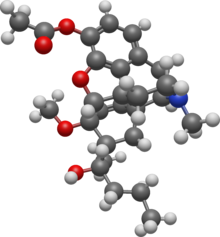Acetorphine
 | |
 | |
| Clinical data | |
|---|---|
| ATC code |
|
| Legal status | |
| Legal status |
|
| Identifiers | |
| |
| CAS Number | |
| PubChem CID | |
| DrugBank | |
| ChemSpider | |
| UNII | |
| KEGG | |
| CompTox Dashboard (EPA) | |
| ECHA InfoCard | 100.291.523 |
| Chemical and physical data | |
| Formula | C27H35NO5 |
| Molar mass | 453.579 g·mol−1 |
| 3D model (JSmol) | |
| |
| |
| | |
Acetorphine is a potent opioid analgesic, up to 8700 times stronger than morphine by weight.[1] It is a derivative of the more well-known opioid etorphine, which is used as a very potent veterinary painkiller and anesthetic medication, primarily for the sedation of large animals such as elephants, giraffes and rhinos.
Acetorphine was developed in 1966 by the Reckitt research group that developed etorphine. Acetorphine was developed for the same purpose as etorphine itself, namely as a strong tranquilizer for use in immobilizing large animals in veterinary medicine. Despite showing some advantages over etorphine, for instance producing less toxic side effects in giraffes,[2] acetorphine was never widely adopted for veterinary use, and etorphine (along with other tranquilizers such as carfentanil and azaperone) remains the drug of choice in this application.
Legal Status
Australia
Acetorphine is a schedule 9 substance in Australia under the Poisons Standard (February 2017).[3] A schedule 9 drug is outlined in the Poisons Act 1964 as "Substances which may be abused or misused, the manufacture, possession, sale or use of which should be prohibited by law except when required for medical or scientific research, or for analytical, teaching or training purposes with approval of the CEO."[4]
Under the Misuse of Drugs Act 1981 6.0 g is the amount required determining a court of trial, 2.0 g is considered intent to sell and supply.[5]
Germany
Acetorphine is illegal in Germany (Anlage I).
Romania
Acetorphine is prohibited in Romania.[6]
United Kingdom
Acetorphine is considered a Class A drug by the UK Misuse of Drugs Act since 1971, making its unlawful possession and distribution illegal. Class A drugs are deemed to be the most dangerous.
United States
Acetorphine is a Schedule I controlled substance in the United States. Its DEA Administrative Controlled Substances Control Number is 9319 and the one salt in use, acetorphine hydrochloride, has a freebase conversion ratio of 0.93.
Italy
In Italy acetorphine is illegal, as are the parent compounds etorphine and dihydroetorphine.[7]
See also
References
- ^ Bentley KW, Hardy DG (June 1967). "Novel analgesics and molecular rearrangements in the morphine-thebaine group. 3. Alcohols of the 6,14-endo-ethenotetrahydrooripavine series and derived analogs of N-allylnormorphine and -norcodeine". Journal of the American Chemical Society. 89 (13): 3281–92. doi:10.1021/ja00989a032. PMID 6042764.
- ^ "The case of etorphine and acetorphine". Bulletin on Narcotics. 1968 (2). UNODC: 51–52. 1968.
- ^ "Poisons Standard". Federal Register of Legislation. Australian Government. October 2015.
- ^ "Poisons Act" (PDF). Western Australia. 1964. Archived from the original (PDF) on 2015-12-22.
- ^ "Misuse of Drugs Act" (PDF). Western Australia. 1981. Archived from the original (PDF) on 2015-12-22.
- ^ "LEGE 143 26/07/2000 - Portal Legislativ". legislatie.just.ro. Retrieved 2024-08-29.
- ^ Salute, Ministero della. "Tabelle delle sostanze stupefacenti e psicotrope". www.salute.gov.it (in Italian). Retrieved 2022-04-09.
External links
- Space filling 3D model and ball & stick 3D model full motion animated rotating of Acetorphine/Acetyletorphine
- 2D nonanimated/nonmoving rendering of Acetorphine/Acetyletorphine as a flat diagram
